Clifford Browder's Blog, page 12
February 2, 2020
448. Monsters: Legend, Fact, and Horror
BROWDERBOOKS
Content for here was lost.
Monsters: Legend, Fact, and Horror
What is a monster? I would say, a large creature that is nonhuman and frightening. Some would add “legendary,” but I’m including real creatures as well. Young people grow up reading about mythical fire-breathing dragons that the hero must slay, in order to obtain the treasure and/or rescue the damsel in distress. Thus Saint George, to save the king’s daughter from being sacrificed, slays a villainous dragon, and Wagner’s Siegfried slays the dragon Fafnir, gets the curse-stricken Rheingold, and wakens the sleeping fire-ringed Brunnhilde.
But boys usually go on to discover the dinosaurs, real creatures that once, eons ago, stalked the earth. I at one time devoured books about these vanished creatures, imagined giant Tyrannosaurs confronting horned Triceratops, or sea-roaming Ichthyosaurs, or Brontosaurs easing their scaly tonnage in Jurassic marshes. These hulking, toothed, scaly creatures had once really lived! Scary, fascinating.
Yes, monsters are fascinating. Medieval maps often marked the edge of seemingly limitless seas with the words, “Here monsters be.” In the Old English epic poem Beowolf, the fell monster Grendel comes forth at night to devour humans, until the young hero Beowolf kills him. And in our own time the Loch Ness Monster in Scotland is said to be seen at intervals, his long neck emerging from the waters, though his actual existence, rumored since ancient times, is hotly debated. Science demands hard evidence, but something else in us hopes that the thing, maddeningly evasive, may secretly exist. Life would be so much more interesting, if it did.
But monsters can be frightening. Long ago on the radio I heard the story of a semi-human marauder who was terrorizing the inhabitants of some region in the far North. This creature murdered people and then tore their teeth out of their mouth. Flying in a helicopter, the deputies out to kill him tracked him running for hours over the tundra below, keeping pace with a wild herd of some kind of animal. Yes, they finally landed and did away with him, but the idea of such a creature of superhuman endurance, mutilating the bodies of his victims, haunted me for years. The dinosaurs were entertaining clowns by comparison.
I myself once killed a monster. It happened long ago when, a refugee from Academia, I was living in a shabby little room on West 14th Street and eating peyote buttons (then not illegal) to induce fascinating Technicolor visions. In the depths of night I was bedazzled by towering Babylons, exotic turbanned males, white clouds that I could turn green, and I myself responsible, by sacrificing my seed to the sun (a bare lightbulb overhead), for the fertility of the entire world. During these grandiose adventures I had just one unpleasant experience. Eyes shut, I saw, dimly taking shape, a form half-human and half-animal, the so-called Missing Link, frightening in its bestial appearance. Aware that this monster was going to terrify me, I simply opened my eyes and made him disappear. Then, without him, the phantasmagoria continued. So I too, without shedding blood, have slain a monster.
Have I ever seen a real-life monster? If one includes large, dangerous creatures, yes: the sharks I have viewed through thick glass partitions in the huge display tanks of the Aquarium at Coney Island. Seeing them there swimming underwater, their big, supple bodies darting and twisting at will, one appreciates that they are streamlined, agile killers, their inward-curved teeth designed so that, once they have their prey in their jaws, the victim’s struggles to escape only drive the teeth deeper into their flesh. The Aquarium sharks are no threat, but I have heard stories of surfers’ agonized screams, as they are borne off by a shark. And I can well imagine how the dangling legs of humans in the sea — perhaps survivors of a shipwreck — could tempt a hungry shark in the wild.
Circus elephants are tamed monsters at best, their wild instincts curbed, so as to render them safe objects for our entertainment, a spectacle both magnificent and sad. As for the lions and tigers pacing in the cages of old-time zoos, they were — and maybe still somewhere are — fit subjects for our pity and indignation. No wonder the Animal Rights crowd exist. To deprive anyone, animals included, of their freedom is, in my mind, despicable. I’ll make exceptions for genuine scientific study, and for zoos and aquariums designed to re-create the creatures’ habitat in the wild, but otherwise I want them free. Yes, exceptions too for the occasional killer bear or other creature, but these are exceptions indeed. Most wild creatures know to keep shy of humans; the odds are terribly against them. We too are killers, often needlessly.
My slain monster was a fantasy, albeit it a scary one. Do such monsters really exist? Indigenous peoples of the region have long told stories of the reclusive Yeti, or Abominable Snowman, an aggressive apelike creature taller than a human said to inhabit the snows of the Himalayas. Western explorers have at times reported seeing huge footprints in the snow, and even, at a distance, hulking upright forms, quite muscular, all but the face covered with hair. Critics have dismissed such tales as hoaxes, or genuine reports mistaking bears for a Yeti, but a hiker’s photographs taken in 1986 have been analyzed and proven genuine.
In 2011 the Russian government organized a conference of experts in Western Siberia that claimed to have “indisputable proof” that the Yeti existed, but critics disputed them and suggested that the conference was really a publicity stunt designed to bring tourists to an impoverished region. Then in 2013 an Oxford geneticist urged all Yeti believers to send him samples of Yeti hair, teeth, or tissue for DNA testing. Of the 36 samples received and tested, most turned out to be from cows, horses, bears, and other animals. But two samples proved to be a perfect match with the jawbone of a Pleistocene polar bear that lived between 40,000 and 120,000 years ago. Then two other scientists tested the same data and said it was from a rare Himalayan subspecies of the brown bear.
So it goes. The Yeti exists or does not exist, is genuine or a hoax, is genuine but simply a familiar brown bear. Believers and nonbelievers fight it out again and again, proving that the creature, real or imagined, truly fascinates us and probably always will.
Paralleling the Yeti and the controversy it provokes is Big Foot, or Sasquatch, an upright, apelike creature of the folklore of the native peoples of North America. Those who claim to have seen him describe him as six to nine feet tall, covered with dark hair, and leaving footprints 24 inches long. Sometimes he is shy and reclusive, living deep in the wilderness, while other accounts make him a menacing creature to be avoided at all costs. Especially common in the Pacific Northwest, sightings are reported from all over North America. As with the Yeti, controversy ages right up to today. There have been numerous hoaxes, and scientists have avoided debated the creature’s existence, lest they give credence to the believers’ claims. The native peoples remain believers, and publicity-seeking laymen will continue to make dramatic claims lacking solid proof. For me, Big Foot’s existence seems more dubious than the Yeti’s, but our fascination with the subject persists.
That some observers may confuse the Yeti or Big Foot with a bear is understandable. I have never met a grizzly face to face, thank God, but I have seen their stuffed carcasses in museums and have read dramatic accounts of encounters. Unlike the Eastern black bear, the grizzly of the West, still found in isolated places, is a formidable 800-pound monster looming up to eight feet high (and yes, they do rear up), with claws that are six feet long. If you meet him face to face, the worst thing you can do is run, since that tells him you are prey and triggers his predator instinct to pursue and kill. It is recommended that you avoid eye contact and slowly withdraw, making soft, unthreatening sounds, so as to avoid any appearance of attack, but also any hint of fear. And if he comes too close, use your bear spray. Okay, good luck. Because, if you run, he can run faster. If escape is impossible, get up in a tree, and if he shakes it, hang on for dear life. The worst possible encounter: a mama grizzly with cubs. Because she’ll do anything, or threaten it, to protect her young.
Grizzlies usually avoid humans, but I recall a tragic story of an attack in Glacier National Park in 1967. Several young people working there one summer were sleeping outside in their sleeping bags, when an aggressive bear appeared. They quickly got up in a tree, and yelled to one girl still on the ground to join them. But the bear had got hold of her bag’s zipper, and she could not get out. “He’s tearing my arm off!” she screamed. While her friends watched in horror, the bear dragged her a certain distance, then screams ceased; she was dead. The bear dragged her mangled body a bit farther off, then left. The incident was reported in the media nationwide; like most people, I was horrified. A party of Park Rangers with rifles went out in search of the bear, killed several. In the claws of one of them were bits of human flesh. This was a rogue bear, atypical. But recently similar attacks have been reported. So even today, monsters do exist, and they kill.
The very thought of surfers dragged off by sharks, or the girl attacked by a rogue grizzly, inspires in me a special kind of horror, unique. The victims in their last moments realize that they are being killed by this brainless beast, this primal force, this thing, and scream in agony. Some would say that the animal is simply following its instincts, and that such attacks don’t merit the moral judgments that attacks of humans on humans deserve. True, but this is a rational argument, and the horror I’m describing has little to do with reason. It’s the brainless power of the shark or the bear, this blind brute force unleashed, that inspires the horror.
I’ll add just one more note. Years ago I heard on the radio — I don’t recall which station — a report of a Big Foot sighting in some small town in the West. A man and a woman having an extramarital affair were so shaken by seeing Big Foot that they reported it to the local sheriff. Usually skeptical of such reports, the sheriff was inclined to take this one seriously. The couple, being involved in an adulterous affair, had good reason not to report their sighting, but report it they did. They must have seen something alarming, concluded the sheriff. That is all I know of the sighting, but it shows how these reports persist, regardless of science’s skepticism. The couple, I’m sure, saw something. But what?
© 2020 Clifford Browder
Published on February 02, 2020 08:49
January 26, 2020
446. Mass Murderer Still at Large
BROWDERBOOKS
Here it is at last: the cover of New Yorkers, my new nonfiction title.
It will soon be available in both print and e-book formats, once certain matters are settled with the two POD (print on demand) printers for self-published books, Amazon and IngramSpark.

Admittedly, it's a gamble, for the illustration is subtle. Every time I look at it, I recognize a new detail that says New York. As for instance:
taxis, buses, bikes, and subway trainshearts, as in I (heart) New Yorka sidewalk vendor's cart with an umbrellaa man joggingan old lamppost that forms an inverted U at the topa TV screenapples (the Big Apple)high heels (fashion)arrows, suggesting movement (New Yorkers are always in motion)BE: people come here to be, or become, themselvesDO: New Yorkers are great doers, always busy
And so on. There are icons I have yet to decipher. Some may be indecipherable. But by all means have a go at it. It's fun.
But will this register with prospective buyers surfing the Internet? I doubt if subtlety sells books. But the two alternatives that my design team offered me -- crowded streets and traffic squeezed in between soaring buildings, seen by day or night -- were the familiar vision of the city, whereas this is strikingly original. I fell in love with it at first glance and have never regretted my choice.
For my other books, go here.
MASS MURDERER
STILL AT LARGE
Her Many Royal Victims
She strikes at many times in many places, and the list of her victims is impressive:
Alexander the Great at Babylon in 323 BCE, ending his planned march into Arabia and North Africa, and setting off a bloody fight among his followers as they carved up the vast territories he had conquered.The Visigothic king Alaric in 410 CE, after sacking the city of Rome, but with Italy still to conquer.Oliver Cromwell in 1658, a good Puritan who refused to take quinine, which he associated with the Jesuits, thus making way (1) for the Stuart restoration in 1660, and (2) countless films and romance novels in the twentieth century idealizing the colorful (and morally slack) Cavaliers, while denigrating those strict, righteous, drab, and depressing Puritans.Lord Byron in Greece in 1824, thus making him a hero of the Greek fight for liberation from Turkish rule, and refurbishing his image as hopelessly depraved, an image that had driven him from Restoration England (itself a bit depraved) into exile.
Had it not been for this ruthless female killer, it has been suggested, Greek might have become the lingua franca (lingua graeca?) of the Western world, Italy might be speaking German today, England might not be a monarchy, and Lord Byron might have become King George Gordon the First of Greece. A bit far-fetched, perhaps, but not impossible.
It should be obvious by now to readers that the murderer discussed here is not a human, but an ailment, a murderous disease. Bubonic plague? Guess again. Small pox? Cholera? The flu? Wrong again. The disease involved is malaria, carried by certain species of the mosquito genus Anopheles, whose bloodsucking females are carriers of various disease-causing parasites, one of those diseases being malaria. And we know whose blood they are sucking, but one might ask, Why? Because, in the insidious biological scheme of things, female mosquitos need blood for protein and other nutrients necessary for developing eggs. Without our blood, they could not reproduce. So we humans are linked to them by nature -- or whoever you want to blame for your summer mosquito bites, and for the world killer malaria, plus yellow fever. The total number of deaths from mosquitos throughout human history? An estimated 52 billion, almost half of all deaths in human history.
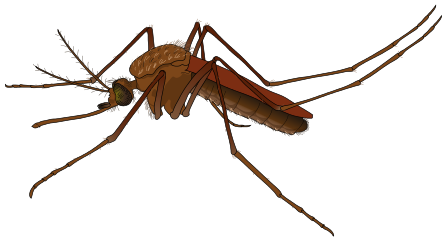 Female mosquito
Female mosquito
Interesting, in a depressing way, but what has it to do with New York, the subject of this blog? Malaria does not plague us here, but in the early nineteenth century every summer brought an epidemic of yellow fever, caused by the mosquito Aedes aegypti. So great a threat, in fact, that well-to-do merchants took their families north, out of the range of the disease, to a sparsely settled community known as Greenwich Village. Then, finding that they could commute from there to their office or store in the city, they decided to buy property and build homes in this quiet, healthy neighborhood. The result: the handsome Greek Revival residences, most of them built in the 1830s, found throughout the Village -- my neighborhood -- today.
 Here she is, at work on human skin.
Here she is, at work on human skin.JJ Harrison
Here I will add a personal note. All my life I have noticed that, in picnics and other social gatherings that lingered into the early evening hours of summer, I was always the first one bitten. I would feel an itching around my ankles, while everyone else was blithely unaware, at first, of the presence of these bloodsucking little predators. I have long since vowed to never kill spiders, since they kill flies and mosquitos. I have embraced that old saying,
If you wish to live and thrive, Let a spider run alive.
If I find a spider in my apartment, I gently deposit it outside a window, so it can find a nearby garden to settle in, spin its web, and kill mosquitos and other pests.
The name "malaria" suggests "bad air," but bad air did not cause or facilitate the spread of malaria; water did, since it helps mosquitos breed. And today, with our greater knowledge of mosquitos and the diseases they spread, are these tiny creatures less of a threat? No way. In 2018 they killed an estimated 830,000 humans. How come? Because of population density: we live in far more congested circumstances than in the past, therefore are more vulnerable. And the poorest and most deprived among us are the most vulnerable to mosquito-borne illnesses. When I traveled years ago in the tropical regions of Mexico, everywhere I saw signs warning of paludismo, meaning "malaria." Today malaria is chiefly confined to rural areas of Mexico not visited by tourists. But in many parts of the world it's definitely a problem. Anopheles is still winning the war.
The villain of the story is the female. So what are male mosquitos doing all this time? Sucking nectar and other juices from plants. But we can't let him off the hook entirely, since he breeds with the female and therefore facilitates her depredations. But when you hear that familiar high-pitched zzzzzzz at night, you can be sure it's a female after your blood.
Source note: This post was inspired by "Suckers," David Quammen's review of "The Mosquito: A Human History of Our Deadliest Predator," by Timothy C. Winegard, in The New York Review of Books, December 5, 2019. Many of the facts I cite are taken by Quammen from Winegard's work.
Coming soon: Monsters: Legend, Fact, and Horror
© 2020 Clifford Browder
Published on January 26, 2020 05:25
January 19, 2020
445. Thank God for Hate
BROWDERBOOKS
Work on the new book creeps along with renewed problems, because of continued frustrations with the new Mac. I was tempted to suspend this blog until further notice, then decided I could manage to do the post below instead. But I may yet have to suspend it, until the worst problems are resolved.
"Don't know what'll come tomorry and don't care one God damn, sir." -- Union soldiers, 1864.
For a clue as to why this so bothers me, see my poem "Neatnik," published online in Blue Lake Review , December 2019.
Thank God for Hate
My endless ordeal adjusting to a new computer has made me think a lot about hate, the kinds of hate, and what it can do to you. As followers of this blog well know, for many reasons I once loved Apple, Inc., but now, with the installation of my new iMac, I have come to hate it. I have succeeded in transferring files from the old iMac to the new one, but the files are frozen, pending my buying Microsoft Word and installing it in the new iMac. This I’ve never had to do before, but I’ve tried repeatedly, and Microsoft has always refused the payment, though no one knows why. Then, with help, I managed to purchase it, but my files are frozen, until I purchase Word, which I have already done. The latest twist: I must uninstall Word and then reinstall it. All this has worn me out. Result: I hate both Apple and Microsoft.
We use the word “hate” rather loosely. I admit to saying, and quite often, “I hate liver” or “I hate pop-up ads,” but this isn’t real hate, just a strong dislike. For me, real hate is visceral, goes deep. It isn’t the feeling of a moment; it lasts. It may subside for a while, but it is still there, waiting for a chance to resurface. And it hardens you, blunts your better feelings, even kills them. So there you have it. Real hate is
VisceralPerennialDestructive
Does my antipathy to Apple and Word go this far? Maybe, maybe not. We’ll see.
Have I ever felt real hate? In my childhood I hated bullies, for I was a bookworm who wore glasses, an easy mark for some aggressive kid eager to play tough and show his manhood. But this never achieved the level of true hate.
There was one teacher, Miss Kiess, whom I feared and came to hate. She was my seventh- and eighth-grade music teacher, a hard little gray-haired woman with a wry, often ironic sense of humor, who delighted in humiliating the weaker kids — the ones deficient in musical ability — in front of the whole class. I feared her, therefore came to hate her. Which shows how hate develops. What we fear, we come to hate. But my hate of her had limits; I didn’t wish her physical harm, I just wanted to be free of her, and finally, after two horrid years, I escaped. My hate of her wasn’t visceral, perennial, or destructive; it didn’t warp my psyche.
Have I ever seen real hate? Once, years ago, while dining in a student restaurant in Lyon, France, I heard a great crash at another table. Everyone, myself included, rushed over to see what was happening. There, confronting one another amid a clutter of smashed dishes, were two male students. One had a look of rage such as I have never seen since; it warped his reddened features. The other, distraught, kept yelling, “Il ne comprend pas la plaisanterie!” (“He doesn't understand a joke!”). An older restaurant employee, a burly male, separated the two, and order was restored, but I have never forgotten the look of rage on that one student’s face. He was on the verge of violence. But was that hate?Visceral and destructive it was, but maybe not perennial. Maybe just the hate of the moment, in which case, by my definition, it isn’t true hate.
Though not usually given to outbursts of rage toward others, as opposed to rage toward God, nature, gravity, destiny, Karma, and myself, I have occasionally felt a surge of anger. Once, when talking on the phone to a male insurance rep about some complicated matter, in exasperation I muttered to myself, “Jesus Christ…!” (I get very religious when angry). The rep immediately announced, “Profanity is not necessary.” His comment enraged me. To my regret, gentility prevailed, for I didn’t shout at him the thought that surged in my mind: “Sir, that remark was not intended for your ears, but since you choose to comment, I will tell you that, if I want to use that kind of language, I fucking well will!” Later, I was surprised by the intensity of my anger. So we are all capable of rage.
But rage is not hate, unless it expresses some deep, persistent feeling. So my righteously proclaimed hate of Apple and Microsoft, though provoked by constant frustration and resentment, is really a momentary outburst of rage. I can’t imagine it lasting forever, nor would I want it to. With ample cause, I’m ventilating, expressing my frustration at the endless complexities of adjusting to a new computer, despite the well-meant attempts of many to help.
* * * * * * The text above is the post I originally intended to publish. But since writing it, I have experienced more troubles with the new Mac, which I have christened the Shitbox. In this post I wanted to include several amusing photos of myself, some showing me smiling goofily and endearingly at my old Mac, while in others I threaten the new Mac with a hammer. The post would have humor, and a light tone at the end. But after further frustrations, being totally unable to insert the photos properly and caption them, I have rejected that conclusion as too feel-goody, too optimistic, too bland, too naive. My anger won’t permit it.
Now I feel my moments of rage hardening into a steady, settled resentment that indeed approximates hate. Not that I’m going to start smashing computers or picketing an Apple store — not my style at all. Instead, I can imagine a quiet, passive, but enduring hate, rekindled at intervals by the memory of previous woes, or worse still, by a repeat of them. Hate doesn’t have to rage and bluster. It can sleep in you and be wakened — perhaps to your astonishment — at intervals. It may warp and harden you, but you can learn to welcome the warp and the hardness, to respect them, even love them. Hate has energy; it makes you feel more alive. It can become an essential part of you, a cherished part, even the core of your being. It can tell you who you are, and in doing so, give you intense satisfaction. So thank God for hate: it gives us energy and joy.
© Clifford Browder 2020
Published on January 19, 2020 04:51
January 12, 2020
444. Mystery Man
BROWDERBOOKS
This is the first post using my new Mac desktop computer. Some of you know the horrors I've been going through, horrors of transition, which I've recounted on Facebook. But also, here's a
FRAUD ALERT
In the course of installing my new printer and computer, I've encountered them three times.
1. Having trouble with my old printer, I googled for help, found myself on the website of some outfit called adv soft LLC that I'd never heard of. A male Asian, fluent in English but with a noticeable accent, worked with me for two hours trying to fix the printer, finally gave up and said I needed a new one -- advice that, even now, I think justified. He then offered me various pricey plans for support, once I got a new one, and I settled for the 6-month plan, subject to my review. I then, in a moment of sanity, googled adv soft LLC and learned that its services were unreliable, and that many complaints had been lodged with the Better Business Bureau. Contacting the outfit, I got a smooth-talking woman and told her I didn't want or need their services. She canceled my plan, but said I would be billed for a one-time session. Though I anticipated a big bite of a charge, I was never billed, probably because I knew too much about them, might cause trouble.
2. While trying to install my new computer, I asked for help, got a phone number online, and got the same male Asian with the same outfit. Once again, I had been lured onto the adv soft LLC website. "I don't know you!" I told him (though I really did) and hung up.
3. The following day, when I tried to sign in to my new computer, I got a dramatic big-screen message that Mac OS X had been invaded by a virus; serious damage would be done, unless you phoned this phone number for help. It sounded a bit like a scam, but when I was blocked again and again from signing in, I tried the phone number, but got no answer because it was early -- before 9 a.m. Then, remembering another phone number given me by Apple Support, I tried it, got an immediate answer, explained the situation, and was told, "Don't phone them. This is a scam!" Up until now, I thought adv soft LLC guilty only of overcharging -- legal and all too common in the capitalist world. But now, with their phone number associated with a scam, questions of legality came up. The Apple Support specialist I was dealing with spent a whole hour trying to remove the malware from my computer, and finally succeeded. Day 2 on my new Mac, and it had been invaded by malware -- what a downer!
FRAUD ALERT: Beware of an outfit called adv soft LLC. They are suspect, have many BBB complaints.
Why is this outfit still in operation? I have no idea. But now, on to another mystery, a man of mystery to many of us.
Mystery Man
He knew Goethe and Jefferson, inspired Darwin, and was celebrated worldwide, yet we don't even remember his name.
Until recently the name “Humboldt” meant only one thing to me: a river in Nevada that in the nineteenth century surged up mysteriously from a spring, then flowed sluggishly in a somewhat westerly direction, and finally sank down into the ground and disappeared. It was a rule among the explorers of that time that if you got lost in a desolate hinterland, the only thing to do was follow a stream until it flowed into a river, and then follow that river, and any larger one it flowed into, until you reached the coast. Rivers were supposed to always flow downstream toward a coast. And what is now the states of Nevada and Utah then constituted the Great Basin, a desolate region where rivers like the Humboldt rose up out of nowhere, flowed on for a while, and then sank back into the earth. God help any lost wanderer who followed them in hopes of reaching the coast.
 Settlers camping by the Humboldt River, 1859 (retouched).
Settlers camping by the Humboldt River, 1859 (retouched).When the westward covered wagons of the emigrants reached this region, hoping to make it over the Sierras into California before the first snow, their trail followed the Humboldt. The native peoples of the Great Basin were not formidable mounted warriors like the Sioux or Cheyenne or Apache, but weaker tribes supposedly pushed by stronger ones into this desolate area, where they survived by eating roots and grasses. The coming of the wagon trails was a blessing for them, since here was food waiting to be snatched. No need to attack the settlers; just send a few arrows into their livestock and wait. The settlers might then carved out some choice meat for themselves, but they would have to lave the carcasses behind. Then, as the wagon trains plodded dustily into the distance, the native peoples would help themselves to a banquet of carcasses. They’d never had it so good. And that was all I knew of the Humboldt River and history, without a clue as to where the name came from, and why, or what the river’s condition is today.
(Note: The above account of the native peoples of the Great Basin along the Humboldt River are my recollection of accounts by the early settlers of that time, who had little interest in studying the aborigines. I doubt if it does justice to the inhabitants of that desolate area, who were probably Paiutes.)
The first traders and pathfinders to discover the Humboldt gave it a series of names, none of which stuck. Then, in 1845, the pathmarker and future presidential candidate John C. Fremont made a map of the region and gave the river its name. So Wikipedia informs us, without bothering to explain who or what Humboldt was. But Fremont knew. Humboldt was Baron Friedrich Heinrich Alexander von Humboldt (1769-1859), the son of a Prussian noble, a much-traveled scientist and explorer famous in his time, but for many of us, forgotten today.
And how do I connect Humboldt to New York City? It’s a strain, I’ll admit, but in 1869, the centennial of his birth, there were worldwide celebrations, and 25,000 people marched along Manhattan’s flag- and bunting-adorned streets in honor of him. Today I have to wonder what scientist’s name could inspire such festivities in this busy metropolis.
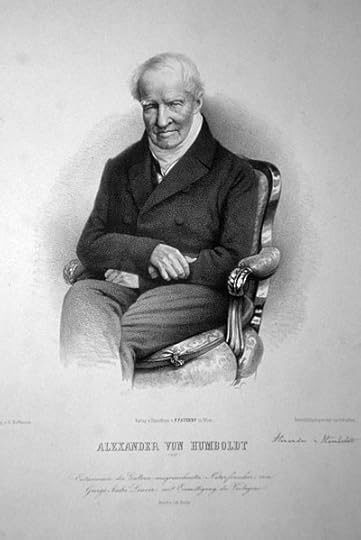 Humboldt in old age, 1857.
Humboldt in old age, 1857.Here I won’t give a detailed account of Humboldt’s lifelong pursuit of scientific knowledge, but only a few highlights.
· Though his widowed mother thought him dull-witted and therefore destined for a career in the Prussian public administration, where she could keep an eye on him, his early contact with the botanist on one of Captain James Cook’s voyages to the Pacific inspired in him a longing to become a world traveler and explorer himself, and so escape maternal domination.· Even though his passport from King Carlos IV of Spain allowed him to visit Spain’s vast holdings in the Americas from 1799 to 1804, he described objectively what he saw there, and denounced Spain’s monopoly of the booming silver mining in Mexico, and the abject poverty of the people in Mexico City.· In 1804, when on his way back to Europe, he was invited to the United States, so President Jefferson could get advice from him about exploring his recent purchase from Napoleon of a huge territory, the so-called Louisiana Purchase, that almost doubled the nation’s size. Jefferson then corresponded with him for years.· In that same year he was introduced to Napoleon, whose subsequent coronation he attended.· He was a friend of Goethe, who shared many of his interests and delighted in his conversation.· The young Charles Darwin signed up for his famous 1835 voyage to the Galapagos Islands as a result of reading Humboldt’s seven-volume account of travels in Spanish America.· In 1827 he began giving lectures to European audiences, free and open to both sexes and all classes, about his earlier explorations in Spanish America. He wanted to summarize all that was known to the natural science of his day, and how it was all interconnected. As a result, he has been hailed by some as the father of environmentalism. · Little of his personal life is known, but he seems to have fought off an attraction to young men in his early days, and later may have fathered three or more children with the wife of a servant whose family lived with him for years.· When, in 1859 at age 90, he died, he received a state funeral in Berlin. Ten years later, in 1869, the centennial of his birth was celebrated worldwide, with festivities in New York, Buenos Aires, Mexico City, Moscow, Alexandria, Egypt, and Melbourne and Adelaide, Australia. His fame, a London newspaper reported, was “bound up with the universe itself.”
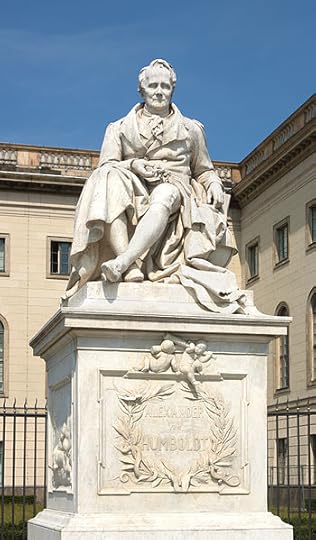 A statue of Humboldt at the Humboldt University in Berlin, 2015.
A statue of Humboldt at the Humboldt University in Berlin, 2015.Christian Wolf
Given his deserved renown, I am chagrinned at learning only now something about the career of a man whose name I formerly associated with a sluggish river in the desolate stretches of nineteenth-century Nevada. Also bearing his name are the Humboldt Current, which flows along the western coast of South America, and the town of Humboldt, South Dakota, in the township of that name, in (I'm not making this up) Minnehaha County.
(Never heard of Minnehaha? For shame! You must never have read Henry Wadsworth Longfellow's epic poem The Song of Hiawatha, published in1855, where she figures prominently as the love interest of the protagonist, Hiawatha. I'll say no more of Longfellow's masterpiece, except that it begins "on the shores of Gitche Gumee," a name that has lived in literary infamy ever since. But I digress; forgive.)
Source note: This post was inspired by “The Magnetic Polymath,” Miranda Seymour’s substantial review of two recent books on Humboldt in the New York Review of Books of December 5, 2019. Which proves that I read more than the Sunday New York Times, though not, I confess, The Song of Hiawatha.
Coming soon: The Killer of Alexander the Great.
© 2020 Clifford Browder.
Published on January 12, 2020 04:36
January 5, 2020
443. Apple, Inc. -- I Hate It
BROWDERBOOKS
I have just acquired a domain name that is unique -- mine, and no one else's:
cliffbrowderbooks.com.
What the point of it is, aside from denying it to anyone else, escapes me. So far, it has proved utterly useless. Maybe I'm doing something wrong. But when some domain name registering outfit offered to register it for only $97, marked down from $300, I knew to immediately delete their e-mail.
If anyone wants to know about any of my books, forget the domain name and go here, to a post devoted to my books, their cover illustrations, summaries, and reviews, and nothing else.
Apple, Inc. -- I Hate It
Hate Apple, Inc., the company I love to love? Until last Friday, such a thought was unthinkable. I hate Big Tobacco, loathe Big Pharma, and harbor undying enmity for Big Oil and certain other conglomerations that pollute our lives, but for Apple, Inc., as longtime followers of this blog well know, I nurse a love that throbs to the very crux of my being. And this when Big Tech -- such monsters as Apple, Amazon, and Google -- are being called to account worldwide. Why this passion of mine? Many reasons:
It gave me my computer, an ancient Mac desktop that I have had for years, ancient but still gamely functioning, the best computer I have ever owned.The nearby Apple store on 14th Street and Ninth Avenue, spacious and flooded with light, has served me well. Smiling young people in blue outfits greet me at the door, answer questions, and give directions, and on the top floor a Genius does wonders to repair or enhance my ancient desktop.Surging to new heights in the market, Apple stock is sexy. It's "with it," it's "hot," it dazzles.As of 2018, Apple has the highest market value ($961 billion) in the world, and is also, with net income of $59 billion, the most profitable.Years ago, on a modest scale, I made what's known as a "killing" in the stock.
About that "killing": years ago, when Apple's cofounder and presiding genius, Steve Jobs, was rumored to be ill, the stock plunged. Jobs was Apple's Wunderkind, the guy who again and again created gadgets that no one needed but everyone wanted, a master of invention and design. Like Edison with the phonograph and the electric light, and like Bell with the telephone, he changed the way we live. In photos he himself was West Coast casual. In contrast to the more formal jacket-and-tie look of Wall Street, he had the California look: super informal, with either a sweater or a shirt with an open collar, and plain, old, ordinary jeans. Which mattered not at all, for his gadgets flew off the shelves, and his computers were slender, sleek, and sexy. But now the market was saying that, without him, Apple would lose its magic, its fantastic moneymaking ways.
 Steve Jobs, displaying a Mac laptop in San Francisco, 2008.
Steve Jobs, displaying a Mac laptop in San Francisco, 2008.
Matthew Yohe
I disagreed. Even without him, I figured, Apple would keep its pizzazz, continue to innovate and dazzle. And so, following the old rule, buy when everyone else is selling, I bought. Not a huge amount, just what I could manage, but I bought. And soon enough, it happened: the stock bottomed out and soared, soared, soared, and with a few slumps along the way, has been soaring ever since. Oh glory! A modest commitment, but the best investment I have ever made. I still get a warm, oozy feeling in my innards knowing that, just this once, I was right when everyone else was wrong. And so, through thick and thin, Apple and its stock are precious to me: my one and only corporate inamorato, my sine qua non, my Big Rock Candy Mountain. Maybe Ayn Rand was right: greed is good. (Of course. But for whom?)
When Jobs, who was indeed ill, left the company, I held on to my stock. Likewise when, in 2011 at age 56, he died of pancreatic cancer, for I had faith in the company and in Jobs's successor, Tim Cook. Though born and raised in Alabama, Cook was another tall, lean, spectacled Californian who favored unpretentious jeans (except when admitted to the Oval Office). And gay, too, as he announced in 2014, the first CEO of a Fortune 500 company to do so. He did it, he said, after getting letters from young kids struggling with their sexual orientation.
One more reason to hang on to my stock: in 2012 Cook declared the first dividend since 1995. It was modest, as dividends go, but a dividend. What else could he do, being under stockholder pressure, with the company sitting on $100 billions in cash? And those billions took him to the White House, whose occupant respects fortunes and success, and to meetings with foreign heads of state as well. Such is our democratic aristocracy. Movie and TV stars have money, fame, and glamour, but CEOs have power and respect, and it takes them far.
bi The gray-haired Cook on the right. We know who's on the left.
The gray-haired Cook on the right. We know who's on the left.
The subject of their talk: trade. April 25, 2018.
Even if Apple could no longer trot out amazing new gadgets, I was sure that just updating the old ones would keep the cash flowing in. And if it opened stores in China, where a new middle class was yearning for Western paraphernalia, and especially for the magic of Apple's products, the inflow of cash could only increase and accelerate. (A concern that took him to the White House for a talk on trade and tariffs.) So I, who dislike gadgets and keep them to a minimum in my life, have continued to love Apple, Inc., and its products. All corporations have their faults, and Apple is no exception, but the very thought of the company still warms me to the cockles of my heart. Until now, at least.
So why this change of heart? Last Friday I made a momentous and long-delayed decision: I would get a new computer. My old one still worked well, but for many reasons it needed to be upgraded, and soon. So I ordered one from Apple -- a desktop like my old one -- and paid an extra $9 for expedited delivery: it would come by 12 noon that very day. Soon I got an e-mail telling me that it had left the warehouse and was on its way. I was thrilled. New vistas opened to me, things my old Mac couldn't do. A new Mac at last: it was really happening!
Tracking it, I learned that it would arrive at 10:59 -- in ten minutes! I got everything ready, knew exactly where I would lodge it, pending installation. But 10:59 came and went: no computer. I tracked it again: it would arrive at 11:30. Hoping they would bring it up the four flights, I planned a generous tip, counted the minutes, paced the floor, waited.
But 11:30 came and went: still no computer. But they were pledged to deliver it by 12 noon; that's what I had paid for. And at 12 noon, predictably now, no computer. Yet tracking said it had been delivered -- an error or a flat-out lie -- for downstairs there was nothing, just an empty vestibule yearning to be filled.
With difficulty I contacted Apple Support by phone, got profuse apologies, was told that they would refund my payment -- not just the $9 but the entire cost of the computer. So my wasted morning ended with the letdown of letdowns: I would have to buy the damn thing all over again!
Like a dank fog, disillusion crept in, dampening my affection for Apple. It had betrayed me in the worst way, raising high hopes only to deflate them. Will I order another Mac? Of course; I've already done so, and it should come next Tuesday. Will I continue to see in Apple, Inc., the object of my dreams, my sine qua, my Big Rock Candy Mountain? Tuesday will tell. Meanwhile, that mountain is beginning to look a bit worn, a bit barren, and maybe more rock than candy. Alas.
Coming soon: As promised before, either a scientist once hailed worldwide but now forgotten by us, or a killer of 52 billion people. Unless, of course, some personal crisis barges in and plants itself in my psyche.
© 2020 Clifford Browder
I have just acquired a domain name that is unique -- mine, and no one else's:
cliffbrowderbooks.com.
What the point of it is, aside from denying it to anyone else, escapes me. So far, it has proved utterly useless. Maybe I'm doing something wrong. But when some domain name registering outfit offered to register it for only $97, marked down from $300, I knew to immediately delete their e-mail.
If anyone wants to know about any of my books, forget the domain name and go here, to a post devoted to my books, their cover illustrations, summaries, and reviews, and nothing else.
Apple, Inc. -- I Hate It
Hate Apple, Inc., the company I love to love? Until last Friday, such a thought was unthinkable. I hate Big Tobacco, loathe Big Pharma, and harbor undying enmity for Big Oil and certain other conglomerations that pollute our lives, but for Apple, Inc., as longtime followers of this blog well know, I nurse a love that throbs to the very crux of my being. And this when Big Tech -- such monsters as Apple, Amazon, and Google -- are being called to account worldwide. Why this passion of mine? Many reasons:
It gave me my computer, an ancient Mac desktop that I have had for years, ancient but still gamely functioning, the best computer I have ever owned.The nearby Apple store on 14th Street and Ninth Avenue, spacious and flooded with light, has served me well. Smiling young people in blue outfits greet me at the door, answer questions, and give directions, and on the top floor a Genius does wonders to repair or enhance my ancient desktop.Surging to new heights in the market, Apple stock is sexy. It's "with it," it's "hot," it dazzles.As of 2018, Apple has the highest market value ($961 billion) in the world, and is also, with net income of $59 billion, the most profitable.Years ago, on a modest scale, I made what's known as a "killing" in the stock.
About that "killing": years ago, when Apple's cofounder and presiding genius, Steve Jobs, was rumored to be ill, the stock plunged. Jobs was Apple's Wunderkind, the guy who again and again created gadgets that no one needed but everyone wanted, a master of invention and design. Like Edison with the phonograph and the electric light, and like Bell with the telephone, he changed the way we live. In photos he himself was West Coast casual. In contrast to the more formal jacket-and-tie look of Wall Street, he had the California look: super informal, with either a sweater or a shirt with an open collar, and plain, old, ordinary jeans. Which mattered not at all, for his gadgets flew off the shelves, and his computers were slender, sleek, and sexy. But now the market was saying that, without him, Apple would lose its magic, its fantastic moneymaking ways.
 Steve Jobs, displaying a Mac laptop in San Francisco, 2008.
Steve Jobs, displaying a Mac laptop in San Francisco, 2008.Matthew Yohe
I disagreed. Even without him, I figured, Apple would keep its pizzazz, continue to innovate and dazzle. And so, following the old rule, buy when everyone else is selling, I bought. Not a huge amount, just what I could manage, but I bought. And soon enough, it happened: the stock bottomed out and soared, soared, soared, and with a few slumps along the way, has been soaring ever since. Oh glory! A modest commitment, but the best investment I have ever made. I still get a warm, oozy feeling in my innards knowing that, just this once, I was right when everyone else was wrong. And so, through thick and thin, Apple and its stock are precious to me: my one and only corporate inamorato, my sine qua non, my Big Rock Candy Mountain. Maybe Ayn Rand was right: greed is good. (Of course. But for whom?)
When Jobs, who was indeed ill, left the company, I held on to my stock. Likewise when, in 2011 at age 56, he died of pancreatic cancer, for I had faith in the company and in Jobs's successor, Tim Cook. Though born and raised in Alabama, Cook was another tall, lean, spectacled Californian who favored unpretentious jeans (except when admitted to the Oval Office). And gay, too, as he announced in 2014, the first CEO of a Fortune 500 company to do so. He did it, he said, after getting letters from young kids struggling with their sexual orientation.
One more reason to hang on to my stock: in 2012 Cook declared the first dividend since 1995. It was modest, as dividends go, but a dividend. What else could he do, being under stockholder pressure, with the company sitting on $100 billions in cash? And those billions took him to the White House, whose occupant respects fortunes and success, and to meetings with foreign heads of state as well. Such is our democratic aristocracy. Movie and TV stars have money, fame, and glamour, but CEOs have power and respect, and it takes them far.
bi
 The gray-haired Cook on the right. We know who's on the left.
The gray-haired Cook on the right. We know who's on the left. The subject of their talk: trade. April 25, 2018.
Even if Apple could no longer trot out amazing new gadgets, I was sure that just updating the old ones would keep the cash flowing in. And if it opened stores in China, where a new middle class was yearning for Western paraphernalia, and especially for the magic of Apple's products, the inflow of cash could only increase and accelerate. (A concern that took him to the White House for a talk on trade and tariffs.) So I, who dislike gadgets and keep them to a minimum in my life, have continued to love Apple, Inc., and its products. All corporations have their faults, and Apple is no exception, but the very thought of the company still warms me to the cockles of my heart. Until now, at least.
So why this change of heart? Last Friday I made a momentous and long-delayed decision: I would get a new computer. My old one still worked well, but for many reasons it needed to be upgraded, and soon. So I ordered one from Apple -- a desktop like my old one -- and paid an extra $9 for expedited delivery: it would come by 12 noon that very day. Soon I got an e-mail telling me that it had left the warehouse and was on its way. I was thrilled. New vistas opened to me, things my old Mac couldn't do. A new Mac at last: it was really happening!
Tracking it, I learned that it would arrive at 10:59 -- in ten minutes! I got everything ready, knew exactly where I would lodge it, pending installation. But 10:59 came and went: no computer. I tracked it again: it would arrive at 11:30. Hoping they would bring it up the four flights, I planned a generous tip, counted the minutes, paced the floor, waited.
But 11:30 came and went: still no computer. But they were pledged to deliver it by 12 noon; that's what I had paid for. And at 12 noon, predictably now, no computer. Yet tracking said it had been delivered -- an error or a flat-out lie -- for downstairs there was nothing, just an empty vestibule yearning to be filled.
With difficulty I contacted Apple Support by phone, got profuse apologies, was told that they would refund my payment -- not just the $9 but the entire cost of the computer. So my wasted morning ended with the letdown of letdowns: I would have to buy the damn thing all over again!
Like a dank fog, disillusion crept in, dampening my affection for Apple. It had betrayed me in the worst way, raising high hopes only to deflate them. Will I order another Mac? Of course; I've already done so, and it should come next Tuesday. Will I continue to see in Apple, Inc., the object of my dreams, my sine qua, my Big Rock Candy Mountain? Tuesday will tell. Meanwhile, that mountain is beginning to look a bit worn, a bit barren, and maybe more rock than candy. Alas.
Coming soon: As promised before, either a scientist once hailed worldwide but now forgotten by us, or a killer of 52 billion people. Unless, of course, some personal crisis barges in and plants itself in my psyche.
© 2020 Clifford Browder
Published on January 05, 2020 05:39
December 29, 2019
442. The King of Harlem
BROWDERBOOKS
My interview with Colleen Chesebro, novelist and word witch, is still available: go here and scroll down. But the link to this blog will get you only to post #417, "Kill," since that was the latest one when the interview was done months ago.
When is a fraud not a fraud?
Nothing new about my forthcoming nonfiction title until the holiday season is over and we're into the New Year. But I'm planning already for entering it in book contests (with caution, since some of them are frauds) and soliciting reviews from trusted sources (with caution, for some of them are frauds). Indeed, what is and what is not a fraud can be debated forever. Everybody wants an author's $$$, and if you see them all as self-serving frauds, you'll end up miserably alone, your books unknown, unreviewed, and unsold. So you get info from online sources (with caution, for ...) and take your chances.
For information about my published books, go to my Amazon Author Central page.
THE STRANGE STORY OF
NICKY LEROY BARNES
The King of Harlem
He swaggered on the streets with a look of bold command. The street kids watched in awe, envying his custom-made suits and shoes, his full-length leather coats, his designer sunglasses and flashy ties. Everything about him said money, power, success. When he drove about in his Mercedes-Benz or his Cadillac, there was often a beautiful woman beside him, and she was not his wife. He was said to be fabulously rich and to have Mafia connections.
Rumors held him responsible for the heroin pouring into Harlem, and even into the rest of New York State, and into Pennsylvania and Canada as well. His investments included gas stations, travel agencies, and apartment complexes. If a police surveillance team tried to follow him as he drove through the streets of Harlem, he led them on a merry chase and often shook them off. He was indeed the King of Harlem, but having beaten several charges, he was known by another name: Mr. Untouchable.
Anyone familiar with chapter 11 of my book Fascinating New Yorkers: Power Freaks, Mobsters, Liberated Women, Creators, Queers and Crazies, will have recognized this swaggerer as Leroy Nicky Barnes, the Mafia’s agent in Harlem in the 1970s. My book recounts Barnes’s ongoing story, climaxed by his appearance, under the name “Mister Untouchable,” on the cover of the Magazine section of the New York Times of Sunday, June 5, 1977 – a cover that I remember well.
That cover, with the dapper, clean-shaven Barnes projecting a look of smug invulnerability, so angered President Jimmy Carter that he ordered his attorney general to "get" Barnes, and get him he did. Trial and conviction followed, with Barnes sentenced to life in prison without parole. Then, learning that his former associates were squandering his fortune, he testified against them, leading to 44 indictments and 16 convictions, one of them for an ex-wife. In return for his cooperation, Barnes got his prison sentence reduced to 35 years.
So why, 42 years after his arrest, am I mentioning the former King of Harlem? Because it has just been revealed that he died of cancer in 2012. And why is this revealed only now? Because, when he was released in 1998, after serving 21 years, he entered the federal Witness Protection Program and lived quietly under an assumed name. As well he might, since his former associates had put out an eight-million-dollar contract on his life.
The New Nicky Barnes
The post-prison Nicky Barnes was not the swaggerer of yore. Bald and limping, he wore baggy dungarees and drove to work in an unpretentious used car. As of 2007 he was working 44 hours a week in an undisclosed job in a middle-class white neighborhood in an undisclosed state, content in his anonymity and routinely taking home doggie bags from restaurants. And how was this known? Because in that year, 2007, he published a memoir, Mr. Untouchable, written with journalist Tom Folsom.
"Nicky Barnes's lifestyle and his value system is extinct," he said that year in an interview. "I left Nicky Barnes behind."
He didn’t want the memoir to glorify him. Being on a tight budget, he just wanted to make a few bucks.
While in prison, Barnes had done more than learn humility. He earned a college degree, taught other inmates, and won a poetry contest for prisoners. He had indeed left the old Nicky Barnes behind. Except that the old Nicky’s story could bring in a bit of needed cash.wo
The key lesson of Nicky Barnes's story: If you're up to your ears in crime, hunker down. The last thing you should want is to attract attention. The smart Mafia men know this; we rarely hear of them, don't even know their names.
For a sketch of Barnes’s life, see chapter 11 of my book Fascinating New Yorkers. You will find more about that title in my post BROWDERBOOKS; scroll down to the NONFICTION section. It is available from Amazon and Barnes & Noble.
Source note: This post was inspired by Sam Roberts's obit of Barnes in the New York Times of Sunday, June 9, 2019.
Coming soon: Two possibilities:
A world-famous explorer and scientist whom Jefferson and Goethe came to know, and who was hailed in New York by 25,000 people marching in the streets, and in Berlin and Moscow and Buenos Aires and Melbourne as well -- a man most of us today have never heard of. The world's most savage killer, responsible for the death of Alexander the Great, the Visigothic king Alaric, Oliver Cromwell, Lord Byron, and some 52 billion other humans over time. Both subjects can be linked, however tenuously, to New York.
© Clifford Browder 2019
.
Published on December 29, 2019 05:32
December 22, 2019
441. The Man Who Saved New York
BROWDERBOOKS
In case you missed it last week, see my interview with Colleen Chesebro, novelist and word witch. For the interview, go here and scroll down. But the link to this blog will get you only to post #417, "Kill," since that was the latest one when the interview was done months ago.
The Man Who Saved New York
It was 1975, not a good year for the city of New York. Streets and bridges lacked basic maintenance, Central Park was littered with trash, its benches unrepaired, its plants untended. Everything about the city looked shabby, dirty, neglected, and crime was high. As a result, families were abandoning the city for the suburbs, shrinking a tax base just when more tax revenue was desperately needed. Then, to make matters worse, citizens were startled by a shocking bit of news: New York City was on the verge of bankruptcy. Not operating at a loss, as it had for years, but on the verge of real, actual, no-other-word-for-it bankruptcy. Its bonds had fallen in price to unprecedented lows, sending the interest rates soaring. But even at such bargain prices, who would risk buying them, if the city might default? The banks, tired of
making loans to a city that always needed more loans, had denied further credit.

“Who’s been minding the store?” citizens asked, their eyes flashing bewilderment and anger. The answer: a long string of mayors who, to avoid the unpleasantness of proposing new taxes to voters, had come up with this or that stratagem, kicking the financial can down the street. For what official, with an election approaching, wants to tell voters that higher taxes and fewer services are desperately required?
It even got personal. When I visited a friend in Washington, and the New York crisis came up in conversation, he launched into a testy diatribe, beginning with “You New Yorkers” – an appellation that I always resented, since I didn’t go around saying “You Washingtonians” or “You Inside-the-Beltway People.” He then informed me, “New York is done, finished, played out! Financially a ruin. It will never recover. A hick town from now on. Kaput!” This too I resented, but could in no way refute. His assertions seemed to be reinforced by the headlines every day.
A great debate raged: should the city be allowed to go bankrupt, or not? Some, including the president, thought that the bankruptcy would and should be no one else’s concern, since the city’s failure would not affect the wider economy; in short, it was New York’s baby to tend to, and no one else’s. But others insisted that New York’s bankruptcy would have a devastating affect on the U.S. economy and global financial markets, therefore the city must be rescued. Being a financial ignoramus, I didn’t know who was right, and didn’t want to let personal bias – my love of New York – sway me. So to my Washington friend and others I proposed, “Since we don’t know how a bankruptcy will affect the nation, the only way to find out is to let it happen. So let the city go bankrupt, and we'll see.” Not the most enlightened solution, but a challenge to those opposing it. Meanwhile, a savvy employee at my local bank was telling clients in no uncertain terms, “Buy New York City bonds! This is the chance of a lifetime. You’ll never see these interest rates again. New York is not going to declare bankruptcy. They won’t let it!”

(In this controversy one sees, playing out yet again, the perennial conflict between upstate and downstate, New York City and Albany. I have discussed it in post #18, “Upstate vs. Downstate: The Great Dichotomy,” which became chapter 21 in my award-winning nonfiction title No Place for Normal: New York / Stories from the Most Exciting City in the World.)
So how did it all turn out, and why bring up now this painful chapter of the city’s distant past? I bring it up because the man who saved the city – yes, it was finally saved – was Felix G. Rohatyn, and he died on December 14, age 91 (my age -- hmm), at his home in Manhattan. That his obit in the New York Times begins on the first page of the front (current news) section of the hefty Sunday Times(very rare), and continues inside for a full page and a half, indicates his significance. So who, younger people may ask, was Felix G. Rohatyn? A hero to some, a villain to others, but he saved the city from bankruptcy.
[This is where you'd expect a photo of Rohatyn, wouldn't you? Sorry, there ain't one. Not without paying a fee. Odd, since he was such a public figure, and photos taken by government photographers in the course of their duty are in the public domain.]
In 1975 Rohatyn was a well-connected and highly respected partner of the Wall Street investment firm Lazard Frères. A financial wizard, he was often consulted by influential businessmen and politicians. “Felix the Fixer,” they called him, not always as a compliment. He was a deal maker, a mastermind of mergers and acquisitions. Then, in late May of 1975, he was summoned to the Midtown offices of Governor Hugh L. Carey and informed that the city was about to default on almost $3 billion in loans: $900 million due in June, $1 billion due in July, and another $1 billion in August. For these men of power, default was out of the question, and they convinced the president. Rohatyn was appointed to an advisory panel that quickly proposed the creation of a Municipal Assistance Corporation (MAC) that would oversee the city’s taxes and spending, a creature of the state that would be independent of the city, with Rohatyn as chairman.
Mayor Beame protested, local politicians fumed, and the city unions screamed, but the governor signed the bill and MAC became the city’s vigilant overseer, and would remained so until 1993. Through financial legerdemain such as only he could orchestrate, Rohatyn got the city through its August obligations, but even that wasn’t enough; investors still didn’t trust the city, wouldn’t buy the bonds that MAC issued. So Albany set up the Emergency Financial Control Board with Rohatyn in charge, to manage the city’s finances.
In September, Governor Carey and his staff met with President Gerald Ford and his advisers in the Cabinet Room in the West Wing of the White House to discuss the financial crisis in New York: a good indication that more than the city was involved.
 The governor and his people on the left, and the president and
The governor and his people on the left, and the president andhis people on the right. Rohatyn in the middle on the left.
Hopefully, the coffee and snacks helped them reach a decision.Suddenly, a hitch: the president threatened to veto the federal loan guarantees proposed by Rohatyn.This was reported memorably by the Daily News of October 29, 1975: FORD TO CITY: DROP DEAD
The president was still convinced that a city bankruptcy would be temporary and tolerable. He changed his mind only when Arthur F. Burns, chairman of the Federal Reserve, returned from a meeting with European leaders to report that his threatened veto would roil global financial markets. So the president backed down and Rohatyn's plan went through.

The city was saved, but at a cost: it had surrendered control of its finances to the state. Was Rohatyn a hero or a villain? As an unelected official, he now had unprecedented control over the city’s finances. To judge by photos, he was a sober, stern-faced man. “I get called in when something is broken,” he explained in an interview. “I’m supposed to operate, fix it up, and leave as little blood on the floor as possible.” What made his intervention successful was his skill in negotiating, backed up by his access to power, his management of public opinion, and his adept use of words as well as numbers. He extracted agreements from bankers and union leaders alike. The result: police layoffs, higher taxes and transit fares, tuition fees for the City University of New York, and subjection to the solons of Albany. Editorialists editorialized, politicians raged, and mayor after mayor complained of the time they had to spend in Albany, begging favors from the state. But the city, at a price, was saved. Only Felix Rohatyn could have pulled it off. No saint, but a hero, not a villain, and that’s how he should be remembered.
In time, the hardy souls who bought MAC bonds at depressed prices reaped a rich reward. As well they might. Think twice and three times before consigning to the financial trash heap the city of New York. If it has the chutzpah to use it, the city has one resource always available: the power to tax, and millions of citizens obliged to pay. (Unless, of course, they have the wealth and wits to hire a good accountant or financial adviser.) But at times the city needs a Felix Rohatyn to plead, wheedle, and browbeat it into action. And the city too, thanks to him, benefited. MAC came to reap substantial surpluses, and Rohatyn channeled these funds into schools, transit, low- and middle-income housing, and the hiring of more police to deal with the crack epidemic of those years.
Some interesting facts about Rohatyn:
· He was born in Vienna in 1928, the only son of a Jewish brewer, his mother the daughter of a prosperous banker.· Hitler’s coming to power in Germany in 1933 prompted the family to move to France in 1934.· In 1942, after France’s defeat, German occupation, and the installation of the collaborating Vichy regime, Rohatyn’s mother, now divorced and remarried, fled Europe, taking few possessions with her. She had her son carry gold coins stuffed in toothpaste tubes.· Resettled in Manhattan, Rohatyn learned English and majored in physics in college.· After time in the U.S. Army, he joined Lazard Frères on Wall Street and was with them for forty years.· Having met her by chance while returning from a trip to Europe, he tutored Edith Piaf in English in the Park Avenue apartment that she shared with other nightclub singers.· By the mid-1970s he felt nostalgia for the world of gentlemen’s agreements that he had known, which was then giving way to hostile takeovers, corporate raiders, and high-risk trading, operations that enrich only a lucky few.

Source note: This post is indebted to Sewell Chan’s obit of Rohatyn in the New York Times of Sunday, December 15, 2019.
Coming soon: The King of Harlem.
© 2019 Clifford Browder
Published on December 22, 2019 04:52
December 15, 2019
440. Five Wonders I Will Never See
BROWDERBOOKS
Don't miss this:
MY INTERVIEW WITH COLLEEN
For my interview with Colleen Chesebro, novelist and word witch, go here and scroll down. But the link to this blog will get you only to post #417, "Kill," since that was the latest one when the interview was done months ago.
I'm still waiting for the e-book formatting to be done, following which copies of my new nonfiction title, New Yorkers: A Feisty People Who Will Unsettle, Madden, Amuse and Astonish You, will become available. I will then show the front and back covers here. For my published books, go here.
I am now up to my ears in SEO -- search engine optimization. Not that I know what I'm doing. What I'm trying to do is figure out what keywords people use that might bring them to my books and blog. This involves a whole new bunch of terms. Do you know what any of these mean?
SERPROICTR CPCPPCARC
The answers are at the end of the post below. Once you see them, all will be clear. In principle, at least.
In my post #424 I listed five things I hate and five weird things I love, with commentary. Here now is another of my fives:
FIVE WONDERS
I WILL NEVER SEE
1. a coral reef2. a painted bunting3. Lake Tear of the Clouds, Feldspar Brook, and the Opalescent River4. the pounding fury of a herd of wild horses galloping5. a huge mass of black ice rising from the polar sea and then sinking back into the water, perhaps never to be seen again.
Commentary:
1. Oceanographer Jacques Cousteau has described coral reefs as resembling dwarf skulls, petrified mauve bushes, witches’ heads, white walking canes by the hundreds, and frozen parasols. Coral reefs are inhabited by feather bonnets that explode into the stinging spines of the lion fish, and moray eels glowering from crevices and baring their savage teeth. Who wouldn’t want to see such wonders, even at the risk of rapture of the depths, when the diver is tempted to explore mysterious populations still deeper, and risks madness and death.
 katyinthecalacademy
katyinthecalacademy
2. Our most beautiful bird, the male flaunting bold splotches of blue, green, and red. Though recently he was spotted in Manhattan, I have never seen him, since normally he disdains the usual south-to-north spring migration path of Eastern birds that brings them to the Ramble in Central Park and to me. Instead, he winters in southern Florida and points south, then migrates westward to the American Southwest, or to coastal Florida, Georgia, and South Carolina. And to make matters worse for birdwatchers, he is secretive and hard to observe.
 DickDaniels
DickDaniels3. The lake is the source of the Hudson River in the far north of the state, high in the Adirondacks. Water from the lake pours into the brook and the river. The very names of all three enchant me.
 Lake Tear of the Clouds
Lake Tear of the Clouds4. I have seen such horses in the 1953 French film Crin blanc (White Mane), which shows them racing about the Camargue, a region in southern France bounded by the Mediterranean on the south, and on the other sides by the two arms of the Rhône delta. Unknown to tourists, the Camargue has lakes and marshlands that are a haven for wild birds, but also, as seen in the film, herds of wild horses, and the French cowboys that try to capture and tame them.
Though I have never seen them, wild horses also run free in the American West, grazing belly-deep in tall grasses, often dotting the hills as far as the eye can see. Having removed them from public land, where their grazing has depleted the grasses, the Bureau of Land Management stores 46,000 of them on some 60 private ranches at a cost that eats up much of the Bureau’s budget. The horses’ natural enemies, wolves and mountain lions, have been eradicated, allowing the horses to reproduce to the point that the grasslands are overgrazed and in danger. But for me, an Easterner who hasn't been on a horse since the summer camp of his childhood (and then unhappily), wild horses suggest a magnificent force of nature that we humans have yet to subdue.
 Not easy to find photos of them galloping.
Not easy to find photos of them galloping.smerikal
 Ordinateur
Ordinateur5. Such a phenomenon is described in Robert Macfarlane’s recent bestseller, Underland: A Deep Time Journey, of which I read a review. He witnessed it in the Arctic. (For more about him, see my post #416, "Descent into Darkness: Revelations, Fecundity, and Death.")
 Black ice in the polar sea, though not what Macfarlane witnessed.
Black ice in the polar sea, though not what Macfarlane witnessed.There will always be wonders that we hear of but will never see. Word of them reminds us of what an incredibly rich, diverse, and complicated world we live in. To deny or ignore such wonders is to deny life and let your sense of wonder atrophy. Without a sense of wonder, life is dull, dead.
SERP. Search engine results page.
ROI. Return on investment.
CTR. Click-through rates.
CPC. Cost per click.
PPC. Pay per clock.
ARC. Advance review copy.
Now all is clear, is it not?
Coming soon: "The King of Harlem." The last word on a flamboyant dazzler and lord of heroin who almost got away with it. Or maybe a scam alert, depending on how things go in the next few days.
© Clifford Browder 2019
Published on December 15, 2019 05:32
December 8, 2019
439. Ten Reasons Why Print Books Outsell E-Books
BROWDERBOOKS
This post is all about books, including mine.
TEN REASONS WHY PRINT BOOKS OUTSELL E-BOOKS
In post #437 I listed the five essentials I cannot do without:
· Bread· Trees· Books· Sleep· Hope.
I then promised an occasional post on each, and proceeded to do Bread. So here is a post on Books.
 Pedro Soler Bueno
Pedro Soler BuenoIt is an acknowledged fact today that print book sales are rising, while e-book sales are falling. How come? Here are ten reasons.
1. A shiny new book is a tactile experience. You touch it, feel its weight, hold it. You can even smell it. It is most definitely there, an experience you never really have with an e-book.
2. You can flip back and forth through a print book, leave a book mark in it.
3. An old print book shows its age and use, shows how important it has been to you. You can read your old underlinings and scribbled marginal notes, and remember why the content mattered to you. The old books on my shelves, their split spines mended with tape, have an aura all their own, even if bits of binding are coming loose. They have shared a good part of my life’s adventure over the years.

4. A print book lets you see how far you’ve come in reading, and how far you have to go. If the content is interesting but challenging, marking progress can help you stay with it.
5. Reading print books causes less eye strain than reading digital books.
6. An unread print book on your desk or bookshelf can haunt you, entice you into reading it. Some 60% of downloaded e-books in the U.S. are never read.
7. Studies indicate that print book readers absorb more information. Which probably explains why having a home library is linked to higher academic achievement.
8. Print book readers are less likely to get distracted.
9. Reading print books helps you sleep better. (It has something to do with the body’s level of melatonin, which induces sleep.)
10.Print books don’t need batteries or a plug and an outlet. You can read them anywhere, as for instance on the beach.
 Credit: Radness.com.au
Credit: Radness.com.auAs an author, I delight in both print-book and e-book sales; the main thing is that people are buying my books. But I grew up with print books, still have some of them from my early years, and value them highly. Think of curling up in an armchair on a cold and windy night, maybe with some fresh-made coffee and a snifter of Courvoisier V.S.O.P. brandy, and a favorite book. Or, minus the coffee and brandy, just with a book.
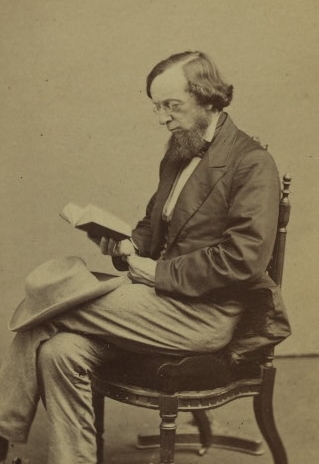
Or think of browsing through that vanishing phenomenon, a used bookstore, maybe with the owner and a napping cat, and finding fascinating old books that you didn’t know existed, or that you’ve been looking for for years.
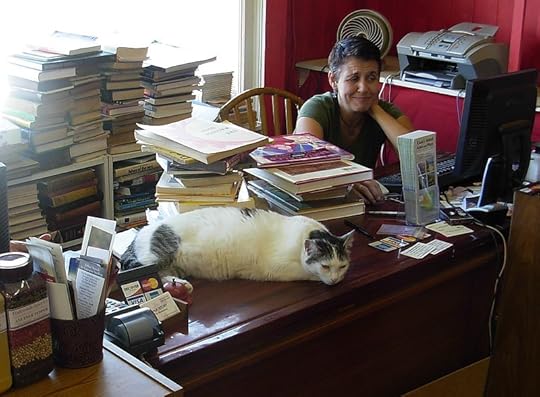 brewbooks
brewbooksOr how about a bookstore with shiny new books that tempt you with their bright covers and catchy titles. Or finding at home an old book you haven’t seen for years, maybe with an inscription from a friend that lets you relive a fragment of your past.
Print books have a long history that digital books lack. In the ancient Middle East clay tablets marked by an instrument called a calamus served as books. But there were problems. They were bulky, clunky things for storage, and you couldn't correct a mistake. I wouldn't have wanted to be the court scribe of any of the Assyrian kings, whose delight it was to castrate a captured enemy monarch before putting him to death.
Then, in Mediterranean societies (Egypt, Greece, Rome), books were papyrus scrolls on which people wrote by hand – in Roman times, often a whole team of educated slaves. Papyrus was made by processing a plant, the papyrus reed. Our word “paper" comes from “papyrus.” But here, too, there were problems. Papyrus scrolls, were crumbly things; unlike clay tablets, they didn't last.
 A 3rd-century BCE Greek papyrus manuscript.
A 3rd-century BCE Greek papyrus manuscript.In the Middle Ages monks sat at desks printing by hand on parchment, which was made by processing the skins of animals. (No animal rightsers back then.) Laborious work, but they did it lovingly, adding elaborate illustrations, termed illuminations, that are highly valued works of art today. And not a bad job, if the Benedictine monastery at Mont-Saint-Michel in Normandy was typical. There, the only heated room in winter was the scriptorium, where such work was done. But parchment was costly and therefore reserved for important works, usually religious.
I have seen clay tablets and papyrus only in museums, but parchment I see daily. Framed on my living room wall are two eighteenth-century parchments that I acquired in Paris long ago: two pages of Gregorian chant, with musical notes and the accompanying Latin text, which I have managed to translate. They dominate the room.
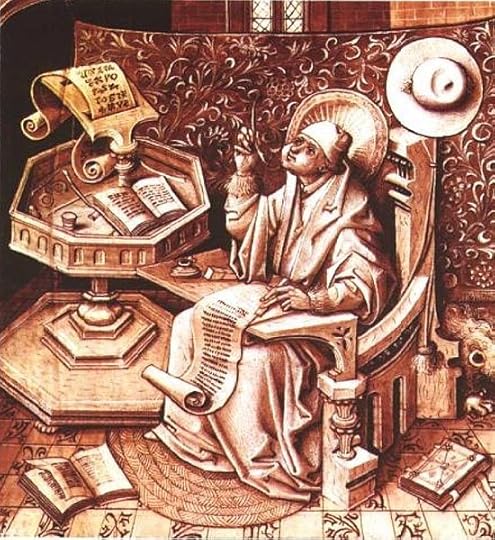
[image error] A Rheims gospel book, with illustrations.
In the late Middle Ages paper, long known in China, where it was made from plant fibers combined with other substances, came to Europe. It was there in Germany in the 1400s to make Gutenberg and the printing press possible, and with them the advent of the printed book as we know it today.
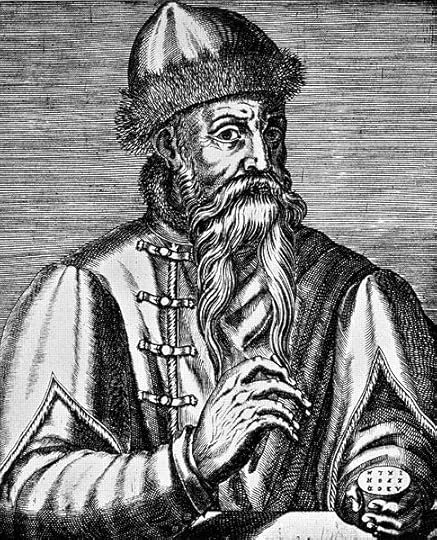 Johannes Gutenberg. A drawing
Johannes Gutenberg. A drawing made after his death in 1468.
Books multiplied in numbers and in time became available to all, which had both good and bad consequences. The peak of book production at that time came in the late 1600s in the Dutch Republic, newly freed from Spanish rule and experiencing a Golden Age that we know chiefly from its paintings. Book production per capita there was ten times greater than in France or Spain, totaling an astonishing 300 million books. It was then that books became a part of daily human experience, and they remain so today. Democracy as we know it depends on a free press, and that means not just newspapers but books.
In the nineteenth century improved technology made the production of paper cheaper. This, combined with better means of communication and transportation, made possible a phenomenon still with us today: the bestseller. Examples:
· Victor Hugo’s Les Misérables (1862), which in one form or another is still with us today. As a high school student, I read a selection from it in a third-year French class.
· Alexandre Dumas’s The Count of Monte Cristo (1844), which in a touring stage version here in the U.S. gave a steady income to Eugene O’Neill’s father, perhaps to the detriment of his theatrical talent. (Over and over again, just this one successful role.) I saw a movie version long ago.
· Alexandre Dumas’s The Three Musketeers (1844), which was also adapted for film. Two major publications in one year! Dumas père sure could turn them out. I’ve seen it as a film, and as a tongue-in-cheek stage production here in New York by the Comédie Française.
· Our own Harriet Beecher Stowe’s Uncle Tom’s Cabin (1852), whose success worldwide astonished both her and her publisher. The reason: it dealt with a subject – slavery – that the country could no longer dodge. An apocryphal story circulated in later years, telling how President Abraham Lincoln, upon meeting Mrs. Stowe at a White House reception during the Civil War, said, “Ah, so you’re the little lady who started this big war!” An exaggeration, if he ever said it (he probably didn’t), but with a touch of truth. A melodramatic stage version circulated for years, and even made its appearance, as an improvised Siamese version, in the 1951 Broadway musical The King and I. I’ve tried twice to read the novel, couldn’t. It’s often referred to as one of the bad good books, or good bad books, esteemed for its historical impact, but not its literary merit.
And of course there were many more bestsellers, some totally forgotten today (works of Sir Walter Scott, for instance), and some remembered, such as works of Dickens, Flaubert, Mark Twain, Dostoevsky, and Tolstoy. But who is generally considered the best nineteenth-century bestseller of all, the one who sold the most books by far? Take a guess. You’ll find the answer under Answer at the end of this post.
And who is the top bestselling author of all time? According to one Internet source, Barbara Cartland, with one billion copies sold. Have you ever heard of her? I haven’t. An author of romance novels, she wrote 723 books in all. But another source says Agatha Christie, with two billion sold. Agatha I have heard of, though I haven't stuck my nose in any of her mysteries. Like it or not, the world needs mysteries and it needs romance.
Use this fileon the web
 Use this fileon a wiki
Use this fileon a wiki
 Email a linkto this file
Email a linkto this file
 Informationabout reusing
Informationabout reusing

 Tom Murphy VII
Tom Murphy VIIAnd now, three more points about books. Print books, of course, and especially mine.
1. PRINT BOOKS MAKE DANDY GIFTS.
It’s the holiday season, and as an author (and therefore vastly self-interested), I urge everyone to give a friend or family member a book. My books, of course, especially the ones I have too many of in my apartment. These are historical fiction, New York City.

The story of a lovable street kid turned pickpocket in nineteenth-century New York. Of all my fictional characters, he is by far my favorite.
"A must read." Five-star Amazon customer review by nicole w brown.
"I can't recommend this book enough." Five-star Barnes & Noble customer review by ladynicolai.
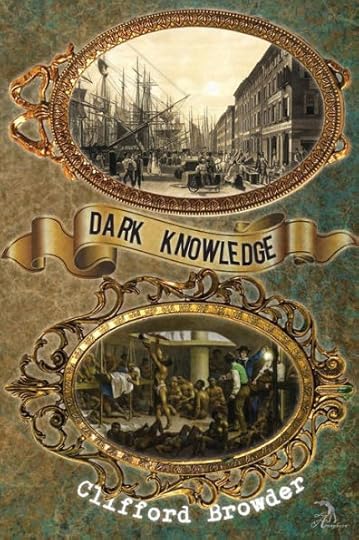 The story of a young man who suspects that members of his family, including a beloved grandfather, may have been involved in the pre-Civil War slave trade. Appalled, at great risk to himself he sets out to learn the painful truth.
The story of a young man who suspects that members of his family, including a beloved grandfather, may have been involved in the pre-Civil War slave trade. Appalled, at great risk to himself he sets out to learn the painful truth."The novel is worth reading and I highly recommend it." Midwest Book Review by Nicole Williamson, retired librarian.
'Thoroughly enjoyed this historical book! I recommend to read! Facts accurate!" Five-star Goodreads review by LisaMarie.

The story of a respectably raised young man who chooses to become a male prostitute in late 1860s New York and falls in love with his most difficult client. Gay romance, but no porn.
"Amazing book and the story line kept me reading on and on." Five-star Goodreads review by Kathy.
"Engaging and provocative." Barnes & Noble editorial review by Sean Moran.
"Absolutely delightful. Five Bees." Gerry Burnie's Reviews.
All books available from Amazon and Barnes & Noble, but these three preferably from the author at $20.00 each plus postage. Contact me by e-email at cliffbrowder@verizon.net. (If you're in the city, we can arrange to meet; that way, no postage.) And if you buy two, half price for the second.
And now, after that grossly commercial and outrageously self-interested spiel, let's finish the list of three more points about books:
2. MY BOOKS ARE GLUTEN-FREE.
3. MY BOOKS ARE MADE IN AMERICA.
But if you don’t buy mybooks, buy someone else’s. Books look great when gift-wrapped; they create expectation and are fun to open.
 Donald Trung Quoc Don
Donald Trung Quoc DonAlso:print books last. Especially hardcovers. But even paperbacks last far longer than an e-book, which has no presence off a computer. So Merry Christmas, Happy Hanukkah, Joyous Kwanzaa, and all the rest. (Here in New York, we do them all.) Whether giving or receiving, may your holiday be blessed with books.

Answer: Harriet Beecher Stowe. Uncle Tom’s Cabin was the no. 1 worldwide bestseller. Not a literary masterpiece, and neither a romance novel nor a mystery. But it came at the right time and said what most needed to be said.
So much for books for now. A fascinating subject.
Coming soon: “Five Wonders I Will Never See.” And after that, probably “The King of Harlem.”
© Clifford Browder 2019
Published on December 08, 2019 06:02
December 1, 2019
438. Rats, Coyotes, Voodoo in New York
RATS, COYOTES, VOODOO IN NEW YORK
The Sunday Times is so huge that you couldn’t read the whole thing in a week. Certain sections I ignore completely: Sports, Styles, Real Estate, and anything for kids. Business gets a glance, Travel and the Arts a longer glance, and Books, Metropolitan, Sunday Review, and the newsy first section are looked at with interest. The Metropolitan section of Sunday, November 24, of this year hooked me with two articles.
The lead article, “Listen: It’s the City’s Call of the Wild,” tells of the city’s amazing wildlife. I had covered this in my post #271, “Wild New York,” on December 11, 2016, which mentioned ravens, crows, osprey, the monarch butterfly, honey bees, and the raccoons of Central Park. But much has happened since then. For cities don’t eliminate wildlife; they develop a wildlife of their own.
 A raccoon. But don't pet them; they don't like it.
A raccoon. But don't pet them; they don't like it.Above all, keep those claws away from your eyes.
Darkone
One bit of New York wildlife that persists, and that commuters often see on the subway tracks while waiting for a train, is rats. So prevalent is Rattus norvegicus that I once devoted an entire post, #219 (February 14, 2016), to the creature, who can be up to 16 inches in length, with a tail just as long. No denizen of the wilderness, he lives where people live, especially in cities, where he feeds on food scraps that we blithely toss away, or deposit in garbage cans that lack a lid. Our parks often have signs warning that they have been treated with rat poison, but the pest still persists. Mayors denounce them, and the city appropriates vast sums to eradicate them, and the clever creature still thrives. Almost legendary was a video of “Pizza Rat,” showing a rat tumbling down some subway steps while dragging along a whole slice of pizza – proof that he’s one tough customer, not easily deterred. A real New Yorker.
 Not Pizza Rat, but a cousin. Notice the handlike claws.
Not Pizza Rat, but a cousin. Notice the handlike claws.Reg McKenna
So what does the Timesarticle tell us? Tell us and show us, I should say, since it involves photos as well as text. The article sums up its message succinctly: “Scavengers scavenge, predators predate, decomposers decompose.” In one photo a raccoon on a park bench seems to be trying to drink from a Coca-Cola can. But the biggest news item for me was that a coyote was spotted recently in Central Park. I knew that the Eastern coyote, which people often mistake for a dog, was making a comeback, and at last report it had reached the outer boroughs, especially the Bronx, where it was seen sniffing and poking about garbage cans in alleyways. But now Wiley Coyote has reached Central Park, in the very heart of Manhattan.
 A coyote in the wild.
A coyote in the wild.Manfred Werner
Other creatures to be seen in, or off the shore of, various sites in the five boroughs: white-tailed deer, diamondback terrapins (a turtle), a painted bunting (rare), beetles, bats, dolphins, even whales. To which I would add many species of migrating birds, and any number of wildflowers, including some so small, sprouting from cracks in sidewalks, that you can see only if you squat down on the pavement and look closely, which few of us are inclined to do. Yes, the supposed urban wasteland is teeming with wildlife.
The other article that hooked me revels not in life but in death. “At the Festival of the Dead,” its caption informs us, ‘Voodoo Is Part of Us.’ ” Yes, Haitian voodoo is alive and well in New York. The article tells how in a dark club in downtown Brooklyn a woman sips Haitian rum while standing near an altar stacked with skulls, candles, cigars, rum, and bowls of (for most New Yorkers) exotic foods. Her face is painted to look hollow like a skull, and she wear s a dark veil and dark skeleton bodysuit. She is the embodiment of Maman Brigitte, a Haitian goddess of death, and with a hundred people around her is celebrating Fet Gede, the Haitian Festival of the Dead, when Haitians dress up in costumes, revel, dance, and drink, in honor of their gods and goddesses, and also the ancestors, those who came before them. It is akin to Mexico’s Day of the dead, and a distant cousin of our own Halloween, whose spooks are a feeble imitation of those the Mexicans and Haitians believe in.
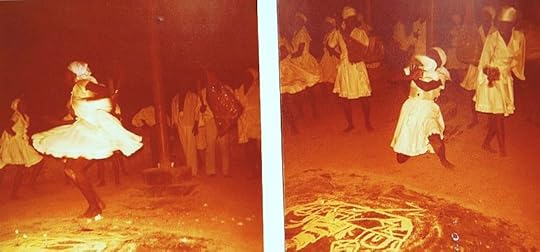 A voodoo celebration in Haiti, 1976.
A voodoo celebration in Haiti, 1976.Fritz Rudolf Loewa
[image error]Downloadall sizes
 Use this fileon the web
Use this fileon the web Use this fileon a wiki
Use this fileon a wiki
 Email a linkto this file
Email a linkto this file
 Informationabout reusing
Informationabout reusing

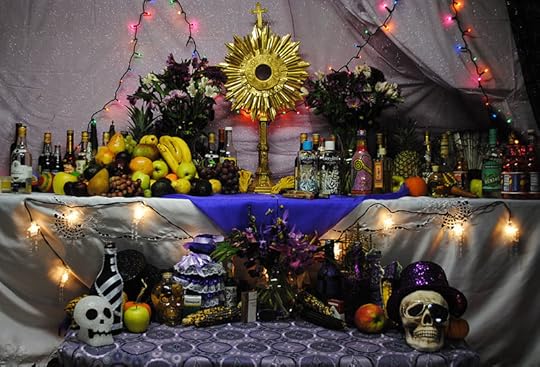 A Haitian voodoo altar during a festival for the spirits, 2010.
A Haitian voodoo altar during a festival for the spirits, 2010.Calvin Hennick, for WBUR Boston
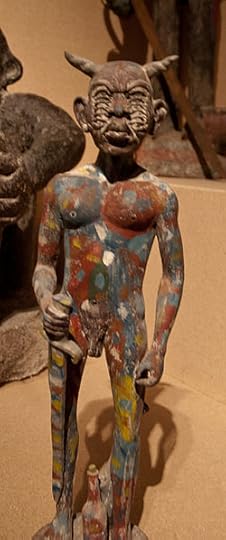 A Haitian voodoo fetish:
A Haitian voodoo fetish:a devil with twelve eyes.
Thom Quine
Today many Haitians – not to mention most outsiders – don’t understand Fet Gede, and voodoo in general. They think it’s all about black magic, pin dolls, and demonic prayers, whereas its believers insist that voodoo is part of who they are, the food they eat, the language they speak. At the festival believers dance to rhythmic drumming, spray themselves with perfume, smoke cigars, scream, and make offerings to the spirits, foremost among whom is Baron Samedi, the god of death, who is also the husband of Madame Brigitte. Far from dour and austere, the Baron and his consort welcome drinking, the erotic, even the obscene. Some participants in the fete paint their faces white, with darkened eyes, nose, and mouth, and succeed in looking downright spooky. To this outsider, the whole affair looks like a festival of joy and life, facing down and eclipsing – or almost eclipsing – the reality of suffering and death.
Just across the page from the article on voodoo is a photograph of a beaming older white woman -- decidedly not Haitian – in a dark dress adorned with a triple string of pearls. Everything about her says health and joy. The photo is an ad announcing the opening of 305 West End Assisted Living, “a new beginning on the Upper West Side.” It announces itself as “the platinum standard in senior care,” and promises “expertise in the latest research-based programming for Alzeimer’s and dementia care,” delivered with grace and compassion by "a truly masterful team." Unmentioned, of course, is the cost of such a facility, which must be astronomical. Clearly, such ads are aimed at the privileged and the rich. And the photo says WASP, of which group I am a member, though the West End facility is not in my plans.
Given the brutal reality of our vulnerabilities, Haitian voodoo offers revelry that turns death into a festival. We Americans, on the other hand, with allusions to dementia but not death, offer a luxury of services to the privileged few. Voodoo vs. capitalism: take your choice. And if you reject this blunt opposition as a simplification of a complex problem, what do you propose instead? Politicians and clergy profess to help, but in the end it’s up to each of us, individually, to make our choice.
Source note: This post was inspired by two articles in the Metropolitan Section of the New York Times of Sunday, November 24, 2019: "Listen: It's the City's Call of the Wild," by Dave Taft; and "At the Festival of the Dead, 'Voodoo Is Part of Us,' '' by Gina Cherelus.
Coming soon: As usual, no idea.
© Clifford Browder 2019
Published on December 01, 2019 04:46



